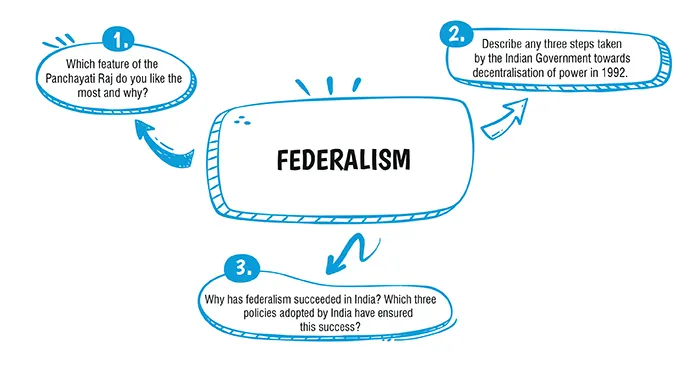Home / Boards / CBSE / Important Questions / Class 10 / Social Science / Federalism
Table of Contents

Ans. (a)
Explanation:
USA, Switzerland and Australia are countries which combined different states together to form a country and hence an example for 'Coming Together' federation.
Ans. (d)
Explanation:
The Concurrent List contains subjects of common interest to both the Union as well as the States. These include education, forest, trade unions, marriage, adoption, and succession. Both, the Central and the state governments can make laws in the Concurrent List.
Explanation:
Panchayati Raj is a system of governance in which Gram Panchayats are the basic unit of administration.
(i) Gram Panchayat is a council consisting of several ward members known as Panch and a Sarpanch. They are directly elected by all the adult population living in that ward or village.
(ii) This feature of Gram Panchayat is very significant. People in a particular village elect their representatives who are very much acquainted or familiar with the local issues.
(iii) Thus, they can solve the problem of people easily and effectively. This is the feature which I liked the most in our country of the Panchayati Raj.
Explanation:
The major steps taken towards the decentralisation of powers in India in 1992 are given below :
(i) It formalised the local self government (Panchayati Raj system).
(ii) It empowers lower level management or people participation in decision making to solve problems and issues at the local level.
(iii) To hold regular elections of the local governing bodies.
(iv) Reserve one third seats for the women in the local self government.
(v) The state governments are needed for the purpose of sharing some powers and the revenue with local self governing bodies.
Explanation:
Federalism is the system of government in which power is shared among the different institutions not within the single constitution body. The constitution outlines the detail of power and functioning of the governments at different levels. India has tried to accommodate all its diversities in its federal set up. The policies that ensures success are :
(i) Linguistic states : States are divided on the basis of the language spoken in the state or region. Eg. Marathi is the language of Maharashtra, Assamese is the language of Assam.
(ii) Language policy : All languages have equal rights. There is no state language in the country.
(iii) Centre state relations : Powers are distributed among the two states and centres.
| Chapter No. | Chapter Name |
|---|---|
| History | |
| Chapter 1 | The Rise of Nationalism in Europe |
| Chapter 2 | Nationalism in India |
| Chapter 3 | The Making of a Global World |
| Chapter 4 | The Age of Industrialization |
| Chapter 5 | Print Culture and the Modern World |
| Geography | |
| Chapter 6 | Resources and Development |
| Chapter 7 | Forest and Wildlife Resources |
| Chapter 8 | Water Resources |
| Chapter 9 | Agriculture |
| Chapter 10 | Minerals and Energy Resources |
| Chapter 11 | Manufacturing Industries |
| Political Science | |
| Chapter 12 | Power – sharing |
| Chapter 13 | Federalism |
| Chapter 14 | Gender, Religion and Caste |
| Chapter 15 | Political Parties |
| Chapter 16 | Outcomes of Democracy |
| Economics | |
| Chapter 17 | Development |
| Chapter 18 | Sectors of the Indian Economy |
| Chapter 19 | Money and Credit |
| Chapter 20 | Globalization and The Indian Economy |
| Chapter Wise Important Questions for CBSE Board Class 10 Political Science |
|---|
| Power – sharing |
| Federalism |
| Gender, Religion and Caste |
| Political Parties |
| Outcomes of Democracy |
CBSE Important Questions Class 10
ICSE Important Questions Class 10
CBSE Important Questions Class 10
ICSE Important Questions Class 10